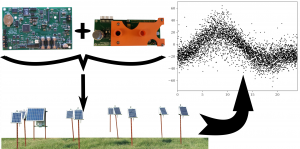Sensor Paper
I finally published my second paper from my dissertation work (see here for the first) developing sensors entitled: Sensor Array for Wireless Remote Monitoring of Carbon Dioxide and Methane Near Carbon Sequestration and Oil Recovery Sites in RSC Advances. As with all of my work, it is published with open access. Get the content from the publisher here, or send me an email to get a preprint. In this paper, my co-authors and I describe the development of the sensors which were deployed at our proving ground in Stillwater, OK. This paper focuses heavily on the hardware supporting the sensors for carbon dioxide and methane. We discuss how the sensor network is arranged in several tiers to reduce the cost of the whole unit. Finally, we show our measurements from the field site. Interestingly, they are much higher than the expected global average at about 13 ppm.
Abstract
Carbon sequestration and enhanced oil recovery are two important geochemical applications currently deployed using carbon dioxide (CO2), a prevalent greenhouse gas. Despite the push to find ways to use and store excess CO2, the development of a large-area monitoring system is lacking. For these applications, there is little literature reporting the development and testing of sensor systems capable of operating in remote areas without maintenance and having significantly low cost to allow their deployment across a large land area. This paper presents the design and validation of a low-cost solar-power distributed sensing architecture using a wireless mesh network integrated, at selective nodes, into a cellular network. This combination allows an “internet of things” approach in remote locations and the integration of a large number of sensor units to monitor CO2 and methane (CH4). This system will allow efficient large area monitoring of both rare catastrophic leaks along with the common micro-seepage of greenhouse gas near carbon sequestration and oil recovery sites. The deployment and testing of the sensor system was performed in an open field at Oklahoma State University. The two-tear network functionality and robustness were determined from a multi-year field study. The reliability of the system was benchmarked by correlating the measured temperature, pressure, and humidity measurement by the network of devices to existing weather data. The CO2 and CH4 gas concentration tracked their expected daily and seasonal cycles. This multi-year field study established that this system can operate in remote areas with minimal human interactions.
